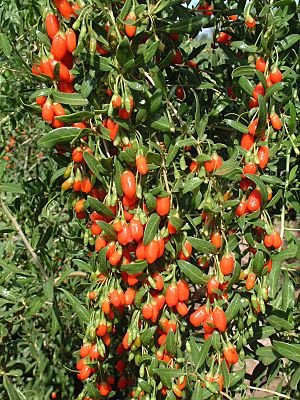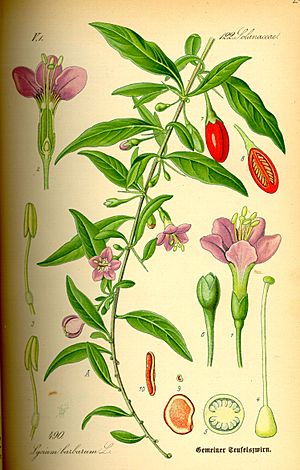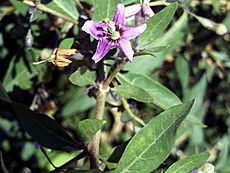Lycium barbarum facts for kids
Quick facts for kids Lycium barbarum |
|
|---|---|
 |
|
| Lycium barbarum with ripe berries | |
| Scientific classification | |
| Genus: |
Lycium
|
| Species: |
barbarum
|
| Synonyms | |
|
|
Lycium barbarum is a type of shrub that originally comes from China. Today, you can find it growing across Asia and in parts of southeast Europe. It is one of two kinds of boxthorn plants that give us the popular goji berry, also known as the wolfberry. The other plant is called Lycium chinense.
This plant has many common names in English. Some people call it the Chinese wolfberry, barbary matrimony vine, red medlar, or just matrimony vine. In the United Kingdom, it's also known as Duke of Argyll's tea tree. This name comes from Archibald Campbell, 3rd Duke of Argyll, who brought the plant to the UK in the 1730s.
The shrub is a very important crop in northern China, especially in the Ningxia Hui Autonomous Region. In Chinese, its name is Ningxia gǒuqǐ.
Contents
Description
Lycium barbarum is a deciduous woody shrub. This means it's a plant with a woody stem that loses its leaves every year. It usually grows between 1 and 3 meters (about 3 to 10 feet) tall. The shrub has branches that arch or bend, and some of its smaller side branches might be short and have no leaves, like tiny spines.
Leaves and flowers
The leaves of L. barbarum grow in two ways. They can grow one after another along the stem, or they can grow in small groups of up to three leaves. Each leaf is green and not very thick. They are usually shaped like a spearhead, which is called lanceolate, but sometimes they have rounded tips. Leaves that grow in clusters are about 25 millimeters (1 inch) long. Single leaves can be up to 55 millimeters (about 2 inches) long.
The flowers usually grow in groups of one to three where the leaf meets the stem. This spot is called the axil. Each flower has a small stalk, called a pedicel, which is 6–15 millimeters long. The flower has a cup-like part called the calyx, which is whitish and has five or six small, triangular parts called sepals. These sepals are shorter than the tube part of the calyx. The sepals are whitish on the bottom and a deep purple on the top.
Each flower has five stamens, which are the parts that produce pollen. These stamens stick out from the flower. The pistil is the part that will become the fruit. The stamens release their pollen by splitting open lengthwise.
Fruit
The fruit of L. barbarum is the main type of goji berry. It is a bright orange-red berry that is shaped like an ellipsoid (like a rugby ball or oval). Each berry is about 1 to 2 centimeters (0.4 to 0.8 inches) across. The green calyx, which was at the base of the flower, splits open as the berry grows.
The number of seeds inside each berry can be very different. It depends on the specific type of plant, called a cultivar, and how big the fruit is. There can be anywhere from 10 to 60 seeds in one berry. The seeds are small, about 2 millimeters long and 1 millimeter wide. They are yellowish and flattened, with a curved inside part.
Reproduction
Lycium barbarum plants can pollinate themselves, meaning they don't need another plant to make seeds. However, insects can also help by carrying pollen from one flower to another. Birds and other animals eat the berries, and when they do, they help spread the seeds to new places. This is how the plant grows in natural areas.
In the Northern Hemisphere, the flowers usually appear from June to September. The berries then ripen from August to October. The exact timing depends on how far north or south the plant is, how high up it is, and the local weather. In places where it doesn't get frosty, the plants keep producing fruit and don't lose their leaves all year round.
Occurrence and cultivation
China
Lycium barbarum has been grown in China for over 600 years. It grows especially well along the rich, flat lands next to the Yellow River. Today, it is still widely grown in the Ningxia Hui Autonomous Region in north-central China. In 2005, about 200,000 acres of land were used to grow these plants.
In 2001, this region produced 13,000 tons of goji berries. This was about 42% of all the goji berries grown in China. The plant is also grown in the Xinjiang Uyghur Autonomous Region in western China.
The berries from L. barbarum are considered the best quality for use in traditional Chinese medicine.
Since Ningxia is next to three deserts, L. barbarum is also planted to help stop erosion. It helps keep the soil in place and turn desert areas back into land where crops can grow.
United Kingdom
Since the 1700s, Lycium barbarum has been used in the United Kingdom to make hedges. It's especially popular in areas near the coast. Its bright red berries are a favorite food for many different kinds of British birds.
The plant still grows wild in UK hedgerows, which are lines of shrubs or trees forming a boundary. In 2003, the Department for Environment, Food and Rural Affairs started a project to protect traditional countryside hedgerows. They specifically mentioned the Duke of Argyll's Tea Tree as one of the plants found in hedges in places like Suffolk, Hadleigh, Bawdsey, and Walberswick.
It is against the law to bring mature Lycium barbarum plants into the United Kingdom from most countries outside Europe. This is because these plants could carry diseases that harm other crops in the same plant family, like potatoes or tomatoes.
Australia
Lycium barbarum was brought to Australia and now grows wild in some coastal areas in the southeast. It is considered an environmental weed in Victoria and Tasmania. You can often find it growing in disturbed areas, native bushland, and along riverbanks. It can form thick patches along rivers. It looks very similar to Lycium ferocissimum, another plant from Africa, and is often confused with it.
See also
 In Spanish: Lycium barbarum para niños
In Spanish: Lycium barbarum para niños



